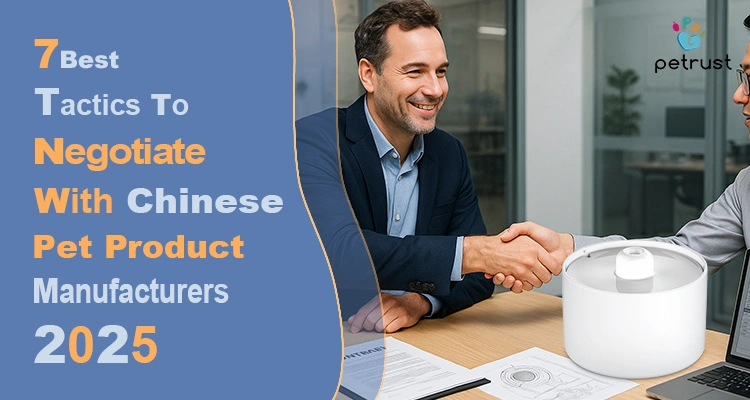Knowing how to negotiate with Chinese pet product manufacturers can make or break your sourcing success—especially when that “perfect” quote turns out not-so-perfect. Maybe the price is higher than you’d hoped. Maybe the MOQ feels out of reach. Or maybe you just aren’t sure how far you can push without hurting the relationship.
If you’re building a pet product brand, launching your next OEM line, or trying to scale without overstretching your budget, smart negotiation isn’t about squeezing your supplier—it’s about finding a win-win. One that protects your margins, ensures quality, and sets the foundation for long-term cooperation.
This guide walks you through 7 practical tactics to help you navigate price, MOQ, payment terms, and more—based on real-world insights from brands already sourcing from China.
New to sourcing? Start with our Complete Guide to Pet Product Manufacturers in China to choose the right partners before entering negotiations.
Why Learning to Negotiate with Chinese Pet Product Manufacturers Matters More Than Ever
The opportunity is real—but so is the pressure.
According to Pet Food Industry, China’s pet food market surged by 9.2% in 2024, reaching US $22.2 billion. Cat food alone hit $9.8 billion, and dog food surpassed $10.3 billion. And that’s just one part of the picture—GlobalPETS projects China’s entire pet industry to exceed $114 billion by 2025, growing at 6.6% annually.
But behind the headlines lies the reality: more global buyers are entering the market, more SKUs are competing on the same digital shelves, and suppliers know it.
That’s why learning how to negotiate with Chinese pet product manufacturers isn’t just about pushing for a better price—it’s about building long-term value. Done right, negotiation helps you:
- Protect your margins without compromising quality
- Build supplier trust and improve flexibility
- Create OEM terms that align with your growth plans
In fast-moving categories like automatic pet feeder, samart cat litter box, wifi-enabled pet water fountain, or eco-packaging, your negotiation strategy can make or break your pet product’s competitiveness.
7 Proven Tactics to Negotiate with Chinese Pet Product Manufacturers Effectively
1. Understand Cost Structures Before You Start to Negotiate with Chinese Pet Product Manufacturers
Before you jump into pricing talks, it helps to understand what actually goes into the numbers you’re seeing. When you negotiate with Chinese pet product manufacturers, you’re not just bargaining over a sticker price—you’re dealing with a complex web of production costs and business realities.
Here’s a breakdown of the main cost components:
- Raw materials – ABS plastic, stainless steel, silicone, etc. Prices here can fluctuate based on global commodity markets.
- Tooling and molds – Especially relevant for custom designs or smart pet tech.
- Packaging and printing – Box type, color printing, custom inserts all affect final cost.
- Certifications – CE, FCC, FDA, and other market-entry requirements.
- Factory markup – Covers labor, overhead, and a fair profit.
So, what’s non-negotiable?
Raw material prices and compliance fees (like certifications) are usually fixed. No factory can go below cost, especially on regulated components.
What can be negotiated?
- MOQ
- Logo printing or branding costs
- Packaging upgrades
- Sampling fees for future batches
Why this matters: Understanding the factory’s cost structure helps you ask the right questions—not just “Can you make it cheaper?”, but “Is there room in packaging, logo setup, or volume tiers?”
Want to make sure your product meets global compliance without overpaying? Check out our Pet Product Certifications Guide (CE, FCC, FDA) to learn what really matters—and what’s worth negotiating for.
2. Use Order Volume as a Conversation Starter—Not Just a Number
When negotiating with Chinese pet product manufacturers, volume isn’t just about quantity—it’s about trust, commitment, and long-term vision. Even if you’re not placing massive orders today, you can still unlock better pricing and value-added services by showing your supplier what’s ahead.
Here’s how smaller or growing brands can use volume more strategically:
- Share your 6–12 month sales forecast to build confidence. It shows you’re serious, organized, and thinking long term.
- Ask for value-adds (like free samples, packaging customization, or logo printing) in exchange for a clear commitment on repeat orders.
- Propose a trade-off: a lower MOQ for the first run in return for a guaranteed reorder if sales targets are met.
Most suppliers aren’t expecting a perfect first order—they’re looking for promising partners. When you share your roadmap and show growth potential, it often opens the door to flexibility, extra support, and stronger collaboration.
3. Timing Is Everything: When to Negotiate with Chinese Pet Product Manufacturers
If you’re planning to negotiate, when you do it can be just as important as how you do it. Many buyers underestimate this—but the right timing can mean the difference between a rigid price and a flexible win-win offer.
Here are a few key moments when Chinese pet product manufacturers tend to be more open, responsive, and ready to collaborate:
- Right After Chinese New Year (Late February to March) – Factories restart with fresh capacity, fewer backlogs, and the motivation to lock in serious clients for the new production cycle. It’s an ideal time to revisit terms or start negotiations from scratch.
- Following Major Trade Shows (e.g., Pet Fair Asia, Interzoo) – Chinese pet product manufacturers are more receptive to deals after big events, where they’ve gathered feedback, tested new products, and are often under pressure to convert leads into orders. Your inquiry will stand out more if it comes during this post-show window.
- Just After Sample Approval – This is when your project becomes “real” in the supplier’s eyes. They’ve invested time and resources, and are keen to move forward. At this point, you have more leverage—use it to finalize pricing, MOQ, or packaging adjustments.
Timing isn’t just a tactic—it’s a way to show respect for your supplier’s rhythms while also protecting your bottom line. When you approach negotiations at the right moment, you’re far more likely to get a “yes” that works for both sides.
4. Compare Thoughtfully Before You Negotiate with Chinese Pet Product Manufacturers
Before entering into any negotiation, give yourself the advantage of perspective. One quote rarely tells the full story—and without a comparison, it’s hard to know what’s reasonable, or where you can push back.
Reach out to at least 2–3 qualified suppliers and compare the following:
- Unit price – Look beyond the number. Ask what’s included (e.g., accessories, customization).
- Lead time – Is it based on current capacity or just a best-case estimate?
- Packaging & value-added services – Do they offer branding support, custom boxes, or inserts?
- Payment & logistics terms – Clarify deposit percentage, balance timing, incoterms, and shipping support.
Doing this groundwork gives you negotiation power based on facts—not assumptions.
For more help evaluating suppliers and samples, check out:
- How to Request and Evaluate Pet Product Samples from China
- How to Choose a Reliable Automatic Pet Feeder Factory in China
5. What Can (and Can’t) You Actually Negotiate with Chinese Pet Product Manufacturers?
If you’ve ever felt unsure about what’s truly flexible in supplier talks—you’re not alone. The truth is, not every line on a quote sheet is set in stone, but some really are.
Here’s a simple breakdown to help you focus your negotiation energy where it counts:
| Often Negotiable | Typically Fixed |
| MOQ | Raw material costs (especially for high-quality plastics or electronics) |
| Payment terms (e.g. 30% deposit / 70% before shipment) | Third-party testing & certification fees (e.g. CE, FCC, PSE) |
| Logo printing setup and unit costs | Injection mold tooling (especially for custom shapes) |
| Packaging design support (standard or custom) | Legal labor wage standards within the factory |
Tip from the field: You’re more likely to succeed negotiating value-added services (like packaging or logo tweaks) than trying to cut into hard manufacturing costs. Focus on building mutual value instead of just pushing for a lower price—and you’ll usually unlock better results.
6. Think Beyond Discounts: Win-Win Negotiation Tactics That Actually Work
Price isn’t the only lever you can pull—and often, it’s not the most effective one. If a pet product supplier hesitates to lower the unit cost, shift the conversation toward value-added benefits that enhance your offer without heavily impacting their bottom line.
Here are a few smart requests that experienced buyers use to unlock better terms:
- Request free accessories—such as extra filters, charging cables, or replacement parts—to boost perceived value for your end customers.
- Ask about custom colors or packaging upgrades that align with your brand, especially if they’re using existing materials.
- Negotiate a sample cost refund once you place a confirmed order. This shows commitment while helping you recoup early-stage expenses.
These small wins can add up to big brand advantages—without forcing your supplier into a corner. At the end of the day, a healthy partnership is built on mutual gain, not just cheaper quotes.
7. Build Real Trust to Negotiate with Chinese Pet Product Manufacturers Long Term
If you’re aiming for sustainable partnerships—not just one-off transactions—trust is your strongest currency.
Most experienced manufacturers don’t just want orders; they want reliable partners who grow with them. When you’re transparent about your goals and treat them like collaborators instead of vendors, they’re far more likely to offer better terms, prioritize your orders, and even co-develop new products with you.
Here’s how you can build real, lasting trust:
- Share your product roadmap – Give them visibility into your long-term plans. It helps them plan resources and production better.
- Give clear and timely feedback on samples – Don’t ghost. Honest, actionable feedback builds rapport.
- Honor agreed payment terms – Paying on time (or early) shows integrity and builds serious goodwill.
- Request audits or video walkthroughs – It signals that you care about quality, not just price, and encourages transparency.
Trust takes time, but it’s the foundation for better pricing, priority production, and smoother collaboration.
Want to audit your factory properly before committing? Check out the Pet Product Factory Audit Checklist (2025): What to Check Before You Order.
Common Mistakes to Avoid When You Negotiate with Chinese Pet Product Manufacturers
Negotiation isn’t just about getting the lowest price—it’s about building a long-term, win-win relationship. Many pet brands unintentionally sabotage that relationship before it even begins. Here are the most common pitfalls to watch out for:
- Jumping into negotiation without clear product specs – If your design, materials, or functions aren’t finalized, your supplier can’t give a realistic quote. Unclear specs waste time on both sides—and lead to mismatched expectations.
- Overstating your first order volume – Hoping for a better deal by promising a high MOQ? Suppliers hear this every day. When the real order is much smaller, trust takes a hit—and so does your negotiating power later on.
- Going silent after the first quote – Ignoring suppliers after they’ve sent pricing or samples sends the wrong message. Even a polite “we’re not ready yet” builds more goodwill than disappearing.
- Chasing the lowest price and ignoring long-term value – A few cents off per unit won’t matter if the supplier delays production, fails QC, or disappears when things go wrong. Prioritize responsiveness, flexibility, and quality—not just cost.
Remember: good negotiation is less about pressure and more about partnership.
When you treat your supplier like a long-term collaborator—not just a cost center—you’re far more likely to get better service, smoother production, and real support when it matters most.
Beyond Price: What Else You Can Negotiate with Chinese Pet Product Manufacturers
Price is just one part of the deal—and often, not the most impactful in the long run. When working with Chinese pet product manufacturers, experienced buyers know that strategic negotiation can unlock much more than just a better quote.
Here are other key areas where you can negotiate to strengthen your supply chain and set your brand up for success:
- Flexible delivery schedules & split shipments – Ideal for managing inventory risk or launching in stages—especially for first-time D2C launches or seasonal campaigns.
- Payment terms that match your cash flow – For example, many suppliers are open to 30/40/30 or similar staged payments. It eases upfront pressure while building trust.
- Integrated branding and localization – Go beyond logo placement—discuss barcoding, packaging design, multi-language instructions, and region-specific compliance labels.
- Clear return and warranty policies – These aren’t just for end consumers—negotiate terms that protect your brand if defects or delays arise.
According to Precedence Research, the global pet care market is set to hit USD 346 billion by 2025, and grow further to USD 643.5 billion by 2034 at a CAGR of 7.1%. That means competition—and customer expectations—will only intensify. Structuring the right terms now can set you apart in the long game.
Buyer Case Study: How One UK Pet Brand Cut OEM Costs by 22%—Without Sacrificing Quality
When a growing UK-based pet brand approached us to develop a smart pet feeder, they had clear goals: lower costs, scale gradually, and still launch with premium features. But like many small to mid-sized brands, they faced common hurdles—high MOQs, pricey add-ons, and hidden logistics fees.
Here’s how we helped them turn things around:
- Secured flexible batch forecasts (3 phased orders) to ease cash flow
- Unlocked free upgrades like custom logo printing & retail packaging
- Reduced MOQ by 50%, from 1,200 to just 600 units
- Saved 22% overall by optimizing design, logistics bundling, and sample approval speed
The result? A high-margin product launch, retail-ready branding, and a repeatable supply plan for 2025.
Looking to achieve similar results? Explore the Top 10 Pet Product Manufacturers in China to find the right OEM partner for your brand.
Frequently Asked Questions: How to Negotiate with Chinese Pet Product Manufacturers
1. When’s the best time to negotiate?
Timing matters more than most realize. You’ll get better responses right after major trade shows (like CIPS or Global Pet Expo), post-Chinese New Year, or once a sample is approved—when suppliers are eager to lock in serious buyers.
2. Can I ask for free samples?
You can—and should—bring it up if your projected order volume is substantial. At Petrust®, we refund 100% of sample fees once your first bulk order is confirmed. It’s about partnership, not one-time deals.
3. What if the supplier won’t lower the price?
Price isn’t the only lever. Smart negotiators look at the full picture:
- Can they offer free or upgraded packaging?
- Shorter lead times or better payment terms?
- Flexible MOQs for a test order?
These small shifts often make a big difference.
Final Thoughts: Smarter, Not Harder Negotiation in 2025
Negotiation isn’t about squeezing every cent—it’s about building clarity, fairness, and value on both sides. When you approach manufacturers with mutual respect and clear goals, you don’t just secure better pricing. You earn:
- Healthier margins
- More favorable terms
- Long-term factory partnerships you can rely on
At Petrust®, we help global pet brands negotiate with confidence—based on real timelines, real factory constraints, and real relationship-building.
Ready to start your sourcing conversation the smart way? Talk to Our Product Team Now








